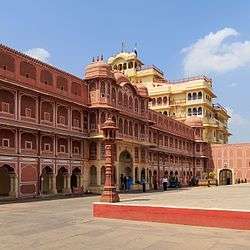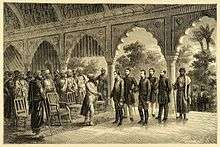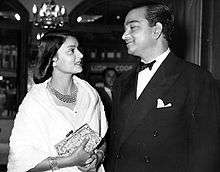Jaipur State
| State of Jaipur जयपुर रियासत | ||||||
| Princely State of British India | ||||||
| ||||||
| ||||||
 | ||||||
| Capital | Jaipur | |||||
| Government | Principality (1128–1948) | |||||
| Maharaja of Jaipur | ||||||
| • | 1128 | Dūlaha Rāya(first) | ||||
| • | 1922–1948 | Sawai Man Singh II (last) | ||||
| History | ||||||
| • | Established | 1128 | ||||
| • | Acceded to India | 1949 | ||||
| Area | ||||||
| • | 1931 | 40,407 km2 (15,601 sq mi) | ||||
| Population | ||||||
| • | 1931 | 2,631,775 | ||||
| Density | 65.1 /km2 (168.7 /sq mi) | |||||
| Today part of | Rajasthan, India | |||||
| | ||||||



Jaipur State was a princely state of India from 1128 to 1948. It was centred on Jaipur town. It existed from the 12th century until Indian Independence in 1947. according to the different periods of history it was also known as Jaipur Kingdom, Amber Kingdom, Dhundhar Kingdom and Kachwaha Kingdom.
History
Jaipur state was founded in the Dhundhar region. Its predecessor state was the Dhundhar (Dausa) kingdom, founded in 1093 by Duleh Rai, also known as Dulha Rao. Jaipur state was known as Amber between the fourteenth century and 1727. In that year, a new capital was built and named Jayapura, then the kingdom was renamed Jaipur.[1]
The modern-day Kushwaha community, of which the Kachwaha form a part, generally claim descent from Kusha, a son of the mythological Lord Rama. This enables their claim to be of the Suryavansh dynasty but it is a myth of origin developed in the twentieth century. Prior to that time, the various branches that form the Kushwah community - the Kachwahas, Kachhis, Koeris, and Muraos - favoured a connection with Shiva and Shakta, but a direct relationship between Kachwahas and these castes can not be eshtablished. Kacchi, Koeri and Murao can be asserted as those castes who have been degraded from Kshtriya status.[2]
Amber Kingdom
In 1561, the chief at Amber, Bharamail Kachwaha, sought support from Akbar, the Mughal emperor. He was formally recognised as a Raja and was invested into the Mughal nobility in return for him giving his daughter to Akbar's harem. A governor was appointed to oversee Bharamail's territory and a tribute arrangement saw Bharamail given a salaried rank, paid for from a share of the area's revenue. The Rajput practice of giving daughters to the Mughal emperors in return for recognition as nobility and the honour of fighting on behalf of the Empire originated in this arrangement and thus the Mughals were often able to assert their dominance over Rajput chiefs in north India without needing to physically intimidate them, especially after their rout of rulers in Gondwana.[3][4]
The ruling dynasty of Amber provided the Mughal Empire with some distinguished generals. Among them were Bhagwant Das, Man Singh I, who fought and governed from Kabul to Orissa and Assam and Jai Singh I.
Jaipur Kingdom
Jai Singh was succeeded by Ramsingh I, Bishan Singh and Jai Singh II. Jai Singh II, also known as Sawai Jai Singh, ruled the state from 1699 to 1743 was a famous mathematician and astronomer and during his rule the new capital city of Jaipur was founded in 1727.
Throughout the disintegration of the Mughal Empire, the armies of Jaipur were in a constant state of warfare. Towards the end of the 18th century, the Jats of Bharatpur and the chief of Alwar (Also a Kachwaha) declared themselves independent from Jaipur and each annexed the eastern portion of Jaipur's territory. This period of Jaipur's history is characterised by internal power-struggles and constant military conflicts with the Marathas, Jats, other Rajput states, as well as the British and the Pindaris (Jaipur's former mercenary allies). The kingdom suffered a disastrous defeat at the hands of the Maratha forces of Mahadji Scindia in the Battle of Patan in 1790.[5] Nevertheless enough wealth remained in Jaipur for the patronage of fine temples/palaces, continuity of its courtly traditions and the well-being of its citizens and merchant communities. A treaty was initially made by Maharaja Sawai Jagat Singh and the British under Governor General Marquis Wellesley in 1803, however the treaty was dissolved shortly afterwards by Wellesley's successor, Lord Cornwallis. In this event, Jaipur's Ambassador to Lord Lake observed that This was the first time, since the English government was established in India, that it had been known to make its faith subservient to its convenience.[6]
In 1818 the Jaipur state became a British protectorate. In 1835 there was a serious disturbance in the city, after which the British government intervened. The state later became well-governed and prosperous. During the Indian rebellion of 1857 when the British invoked the treaty to request assistance in the suppression of rebellious sepoys, the Maharaja opted to preserve his treaty, and thus sent in troops to subdue the uprisings in the area around Gurgaon.
Jaipur's last princely ruler signed the accession to the Indian Union on 7 April 1949.[7]
Rulers
The Maharajas of Jaipur belonged to the Kachwaha dynasty.[8]
- 1699 - 21 Sep 1743 Sawai Jai Singh II (b. 1688 - d. 1743)
- 1743 - 12 Dec 1750 Sawai Ishwari Singh (b. 1721 - d. 1750)
- 1750 - 5 Mar 1768 Sawai Madho Singh I (b. 1728 - d. 1768)
- 1768 - 13 Apr 1778 Sawai Prithvi Singh II (b. c.1762 - d. 1778)
- 1778 - 1803 Sawai Pratap Singh (b. 1764 - d. 1803)
- 1803 - 21 Nov 1818 Sawai Jagat Singh II (b. ... - d. 1818)
- 22 Dec 1818 – 25 Apr 1819 Mohan Singh (regent) (b. c.1809 - d. ...)
- 25 Apr 1819 - 6 Feb 1835 Sawai Jai Singh III (b. 1819 - d. 1835)
- Feb 1835 - 18 Sep 1880 Sawai Ram Singh II (b. 1835 - d. 1880)
- 18 Sep 1880 - 7 Sep 1922 Sawai Madho Singh II (b. 1861 - d. 1922)
- 7 Sep 1922 – 15 Aug 1947 Sawai Man Singh II (b. 1912 - d. 1970)
- 24 June 1970 -28 December 1971 Bhawani Singh (b.1931-d 2011)
- 28 April 2011 – Present Maharaj Kumar Padmanabh Singh
Nizamats
The Nizamats (governorships) of Jaipur State were the following:
- Jaipur
- Daosa
- Hindaun
- Gangapur
- Kot Kasim
- Sawai Madhopur
- Malpura
- Sambhar
- Shekhawati
- Torawati
Thikanas
The Thikanas (estates) of Jaipur state were:
Tazimi Thikana
Paid upwards of Rs 25000 in state times to the Jaipur state.[9]
- Khareda (Title of Thakur) (Clan Surtanots)
- Pipla
- Dhula (Rajawat)
- Barwara (Rajawat)
- Chomu (Title Thakur)(Clan Kacchhawa - Nathawat) - boasts of many Modern Indian Army / Navy greats
- Samode (Title Thakur, Personal title Rawal)(Clan Kacchhawa - Nathawat)
- Kalwada(कलवाड़ा)
- Diggi (Khangarot)
- Aluda
- Padli
- Dooni (Kacchhawa- Gogawat)
- Achrol (Title Rajadhiraj from Mewar, Kacchhawa - Balbhadrot)
- Padampura
- Shahpura (Title of Roa and head of all the Shekhawat Clan)
- Garh Taknet (Kacchhawa - Shekhawat)
- Baniyana
- Gudha(chander ji)
- Geejgarh
- Guhala
- Dangarthal
- Marwaa
- Dudu (Title Thakur, Khangarot)
- Saawli (Nathawat)
- Morija (Title of Thakur)(Clan Nathawat)
- Saawarda (Khangarot)
- Doongri (Title Thakur)(Nathawat)
- Madhogarh(Bhati)
- Mandaa (Khangarot)
- Malsisar (Title Thakur)
- Mandrela (Title Thakur)
- Baghera
- Mehndwaas (Khangarot)
- Khaatu
- Natwaara (Kacchhawa - Nathawat)
- Mundota (Kacchhawa - Nathawat)
- Kaalwaar (Kacchawa - Kalyandasot)
- Jobner (Khangarot)
- Karansar (Title of Thakur)(Clan Sisodiea)
- Siras
- Daanta (Shekhawat)
- Saakoon (Khangarot)
- Saantha (Title Thakur)(Clan Rathore)
- Kanota (Title Thakur)(Clan Rathore)
- Nailaa (Title Thakur) (Clan Rathore)
- Ajayrajpura (Title of Thakur)(Clan Nathawat)
- Kheda
- Mahaar (Shekhawat
- Sheopur
- Alsisar (Title Thakur) (clan shekhawat)
- Mukangarh (Title of Thakur) (clan shekhawat)
- Mahansar (Title of Thakur) (Clan shekhawat)
- Bhuteda (Title of Thakur) ( Clan Nathawat)
Khas Chauki
Paid upwards of Rs 10000 in state times to the Jaipur state.[9]
- Talchidi ( Title of Thakur) (Clan Badgujar)
- Bicchao
- Renwal
- Padasoli
- Pachar
- Chitora
- Rausi
- Kailai
- Ramgarh
- Kheri
- Jadawata - Paid no tribute but rendered service by Cavalry.[10]
Mamlaguzar
Special Category, included some of the most prominent families[11] of Jaipur state. Paid nazrana upwards of Rs 30000 in state times to the Jaipur state. Most were closest to the King and his family, others were most prominent and possessed their own army and served directly under Mughals in Middle Ages. All of these were hereditary Tazimi Thikana.
- Jhalai - A younger branch of Jaipur seat, in case of vacancy, the future king was adopted from Jhalai. (Clan Rajawat)
- Isarda - A younger branch of Jhalai seat, in case of vacancy, the future king was adopted from Isarda.(Clan Rajawat)
- Baler - A younger branch of Jhalai seat, in case of vacancy, the future king was adopted from Baler as jhalai and Isarda had no issue Baler became the first choice. (Clan Rajawat)
- Siwar (Clan Rajawat)
- Bissau,& Surajgarh (3rd Biggest Thikana of Jaipur State & Personal title of Rawal)(Clan Shekhawat)
- Khendela (Title of Raja) (Clan Shekhawat)
- Dundlodh (Clan Shekhawat)
- Khetri - 2nd Biggest Thikana of Jaipur and biggest in Panchpana confederation.(Title Raja)(Clan Shekhawat)
- Nawalgarh (Personal Title of Rawal)(Clan Shekhawat)
- Mandawa (Title of Thakur)(Clan Shekhawat)
- Sikar - Biggest Thikana of Jaipur(Title of Roa)(Clan Shekhawat)
- Lawan (Title of Raja)
- Uniara (Title of Roa)(Clan Naruka)
- Lawa
- Nimera
Chakotidar
- Patan - Torawati, a separate estate of Tomar Rajputs.[12]
- Mundru - Torawati, a separate estate of Shekhawat Rajputs.[13]
Jaipur Residency
The Jaipur Residency was established in 1821. It included the states of Jaipur, Kishangarh and Lawa. The latter had belonged to the Haraoti-Tonk Agency until 1867.[14]
See also
References
- ↑ Princely States of India
- ↑ Pinch, William R. (1996). Peasants and monks in British India. University of California Press. pp. 12, 91–92. ISBN 978-0-520-20061-6. Retrieved 22 February 2012.
- ↑ Wadley, Susan Snow (2004). Raja Nal and the Goddess: The North Indian Epic Dhola in Performance. Indiana University Press. pp. 110–111. ISBN 9780253217240.
- ↑ Sadasivan, Balaji (2011). The Dancing Girl: A History of Early India. Institute of Southeast Asian Studies. pp. 233–234. ISBN 9789814311670.
- ↑ Malleson, G. B.: An historical sketch of the native states of India, London 1875, Reprint Delhi 1984
- ↑ Giles Tillotson, Jaipur Nama: Tales from the Pink City.
- ↑ Jaipur (Princely State)
- ↑ Jaipur Princely State (17 gun salute)
- 1 2 Studies In Indian History: Rajasthan Through The Ages,By R.K. Gupta, S.R. Bakshi
- ↑ "List of Khangarot Chiefdoms". India Royalty. Retrieved 2014-04-04.
Jaipur Vassals
- ↑ Studies In Indian History: Rajasthan Through The Ages,By R.K. Gupta, S.R. Bakshi, Page 92
- ↑ Studies In Indian History: Rajasthan Through The Ages,By R.K. Gupta, S.R. Bakshi, Page 91
- ↑ "Census 1941". India Royalty. Retrieved 2014-04-04.
Sl. 166, Torawati Tehsil & Nizamat, Census 1941, Swami Prakash Chandra Bar-at-law, Officer-in-Charge, Census Operations, Jaipur State
- ↑ Imperial Gazetteer of India, v. 16, p. 156.
External links
| Wikimedia Commons has media related to Jaipur State. |
Coordinates: 26°55′34″N 75°49′25″E / 26.9260°N 75.8235°E

